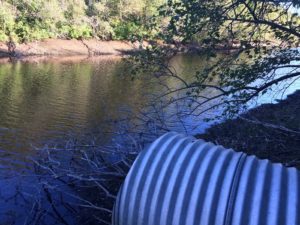PROBLEM | The Upper and Lower Rainbow Ponds of the 100 unit East Passage community in Jamestown, RI were built primarily to collect and retain stormwater runoff from drainage infrastructure in the development. The ponds are also an aesthetic and recreational draw for the community. Walking paths surround the ponds, there is some catch and release fishing, and residents enjoy the birds and aquatic life that the pond attracts and supports. In recent years, however, algae growth has rapidly increased and sediment has accumulated from over 30 years of erosion and re-deposition. Additionally, erosion around the culvert pipes also adds sediment to the ponds.

A pipe delivering stormwater to the Upper Pond at East Passage Estates, RI
SOLUTION & METHOD | Truslow RC completed a baseline evaluation of the ponds to develop a snapshot of conditions after a very dry summer and fall. Low pond levels from the recent drought allowed for easy access to the stormwater inlets and outlets and pond features that were usually below the water line. To carry out the evaluation we:
- Measured water depth and sediment depth at four transect locations, two at each pond,
- Sampled water and sediment from the upper and lower ponds for field and laboratory analysis,
- Installed shallow water temperature sensors, and
- Observed and noted the condition of stormwater infrastructure entering the ponds.
Our research and evaluation of the upper and lower ponds determined the following:
- Excess algae in the ponds is likely the result of excess nutrients (phosphorus, nitrogen) from stormwater runoff and septic system discharge;
- Sediment is accumulating in the ponds from many years of stormwater runoff from land areas adjacent to the pond;
- Groundwater may sustain the pond during periods of low rainfall;
- Long periods of low rainfall lead to lower than normal pond levels and the lack of natural dilution or flushing adds to the nutrient concentrations and algae growth problem;
- Dissolved oxygen (DO) was generally high and sufficient to sustain the observed fish/amphibian population;
- Increases in algae and other pond vegetation may eventually decrease DO to levels that would be harmful to pond dwellers;
- Continued sediment deposition will continue to fill the ponds, decrease stormwater storage capacity; allow storage of excess nutrients, impact dam/pond safety, and impact water quality if measures are not taken to address these issues.
Several measures were identified to help improve pond water quality and materials and resources were provided to the residents during an annual homeowner’s meeting. These include:
- The use of rain gardens and stormwater infiltration on individual properties to reduce stormwater runoff to drainage structures that flow to the ponds,
- Prudent use of landscaping chemicals and vegetation to reduce runoff of excess nutrients;
- Repair and stabilization of erosional features at outlet discharge areas,
- Evaluation of any pipe blockages that were observed and reported,
- Use of stone and vegetation at outlets to reduce erosion and capture sediment before it enters the pond,
- Mechanical removal of aquatic vegetation to prevent buildup on pond bottom;
- Regular inspection of discharge areas, and
- Continued citizen water sampling to assess water quality changes.
Project Highlights:
- Baseline Water Quality Evaluation
- Pond water quality and pond sediment sampling
- Presentation and development of pond maintenance guidelines for homeowners
Client
- East Passage Estates Lot Owners Association (EPLOA)